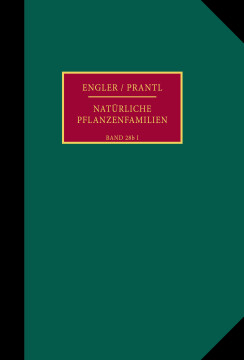Die natürlichen Pflanzenfamilien nebst ihren Gattungen und wichtigsten Arten, insbesondere den Nutzpflanzen

BOOK
Cite BOOK
Style
Format
Die natürlichen Pflanzenfamilien nebst ihren Gattungen und wichtigsten Arten, insbesondere den Nutzpflanzen
Unter Mitwirkung zahlreicher hervorragender Fachgelehrter begr. von A. Engler / K. Prantl. Band 28 b I: ANGIOSPERMAE: Ordnung Gentianales, Fam. Loganiaceae. Bandred.: A. J. M. Leeuwenberg
Editors: Engler, Adolf | Harms, Hermann | Mattfeld, Johannes | Werdermann, Erich | Eckardt, Theo | Hiepko, Paul | Melchior, Hans
(1980)
Additional Information
Book Details
Pricing
Table of Contents
| Section Title | Page | Action | Price |
|---|---|---|---|
| Vorwort der Herausgeber | V | ||
| Authors | VI | ||
| Contents | VII | ||
| Introduction | 1 | ||
| 1. General discussion of relationships between the taxa inside and with taxa outside the family | 3 | ||
| 2. Taxonomy | 8 | ||
| 2. 1. Introduction | 8 | ||
| 2. 2. History of the family | 8 | ||
| 2. 3. Survey of 6 arrangements of Loganiaceae genera | 10 | ||
| 2. 4. Geographical distribution | 13 | ||
| 2. 5. Cultivated species | 15 | ||
| 2. 6. Morphology | 15 | ||
| 2. 7. Relationships with other families | 19 | ||
| 2. 8. Relationships between tribes and genera | 19 | ||
| 2. 9. Diagnosis of the family, with references | 20 | ||
| 2.10. Key to the genera | 21 | ||
| 2.11. Descriptions of tribes and genera | 24 | ||
| I. Spigelieae | 24 | ||
| II. Loganieae | 30 | ||
| III. Strychneae | 34 | ||
| IV. Plocospermeae | 50 | ||
| V. Gelsemieae | 50 | ||
| VI. Antonieae | 55 | ||
| VII. Buddlejeae | 61 | ||
| VIII. Retzieae | 76 | ||
| IX. Potalieae | 78 | ||
| X. Desfontainieae | 87 | ||
| 2.12. References | 91 | ||
| 3. Vegetative architecture | 97 | ||
| 3. 1. Introduction | 97 | ||
| 3. 2. Figures with descriptions | 97 | ||
| 3. 3. References | 108 | ||
| 4. Anatomy of the secondary xylem | 112 | ||
| 4. 1. Introduction | 112 | ||
| 4. 2. Material and acknowledgements | 113 | ||
| 4. 3. Methods | 114 | ||
| 4. 4. General description of the wood structure of the family | 115 | ||
| 4. 5. Key | 117 | ||
| 4. 6. Descriptions of the genera, with notes | 119 | ||
| 4. 7. Unusual features of the wood | 154 | ||
| 4. 8. Conclusions | 156 | ||
| 4. 9. References | 159 | ||
| 5. Pollen morphology | 162 | ||
| 5. 1. Introduction | 162 | ||
| 5. 2. Description of the pollen types in the tribes | 162 | ||
| 5. 3. Discussion | 189 | ||
| 5. 4. References | 191 | ||
| 6. Embryology | 192 | ||
| 6. 1. Introduction | 192 | ||
| 6. 2. Anther-wall formation, microsporogenesis, and microgametogenesis | 192 | ||
| 6. 3. Ovule, megasporogenesis, and female gametophyte | 193 | ||
| 6. 4. Development of the endosperm | 197 | ||
| 6. 5. Embryogeny | 199 | ||
| 6. 6. Development and anatomy of the seed coat | 199 | ||
| 6. 7. References | 201 | ||
| 7. Cytology | 202 | ||
| Table 7.1. Basic chromosome numbers in the tribes | 204 | ||
| Table 7.2. List of chromosome numbers of all the species studied cytologically | 205 | ||
| 7. 3. References | 209 | ||
| 8. Phytochemistry | 211 | ||
| 8. 1. Descriptions and discussions | 211 | ||
| 8. 2. Conclusions | 232 | ||
| 8. 3. References | 233 | ||
| 9. Useful plants | 238 | ||
| References | 242 | ||
| 10. Index of plant names | 245 | ||
| 11. Index of plant constituents | 254 |
